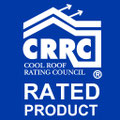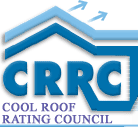Approvals and Ratings

The Paint and Coatings Industry has developed quality and performance standards for manufacturers and their products.
The standards provide the consumer with quantifiable information as to what a product is and how it should perform.
EnviroCoatings participates with a number of product quality and performance rating bodies and organizations associated with the Paint and Coatings Industry.
EnviroCoatings products are Lab-Tested and Real World Certified
Ceramic InsulCoat Wall
PACE Programs - Heat Reflective - Cool Wall
PACE (Property Assessed Clean Energy) is a simple and effective way to finance energy efficiency, renewable energy, and water conservation upgrades to buildings. PACE can pay for upgrades for almost any property - homes, commercial, non-profit, and agricultural.
Ceramic InsulCoat Wall meets the eligibility specifications for use as a
PACE Energy Efficiency Improvement in the
Heat Reflective - Cool Wall Coatings Product Category.
PACE is scaling up across the Country, as States enact PACE enabling legislation and programs launch. EnviroCoatings is approved for use with a growing list of PACE Programs:
Visit the PACE Energy Efficiency Programs Section for additional information.
The Master Painters Institute

MPI is an Institute dedicated to the establishment of quality standards and quality assurance in the painting and coating application industries in the U.S.A. and Canada.
Approved Products List
The Master Painters Institute have been qualifying products for the Approved Products List since 1967.
The Approved Products List is not unlike any "QPL" (Qualified Products List). In fact, a number of cities and other agencies are using the MPI Approved Products List as their "QPL," as do hundreds of architects, specification writers, building owners, property managers, condo councils, and government agencies.
An example of acceptance by government is the recent adoption of MPI standards by the U.S. Navy
Professional Organizations Reference MPI
The MPI Architectural Painting Specification and Maintenance Repainting standards are presently referenced by the Dept. of Defense Unified Facilities Guide Specification, the AIA’s MasterSpec, SpecLink, GSA, the Canadian Government’s National Master Specification, and many others.
NOTE: MPI does not qualify and list Roof Paints and Coatings
Additional Cool Wall Information
Visit the Cool Wall Section for additional information.
Ceramic InsulCoat Roof
You can be confident that Ceramic InsulCoat Roof will meet your Cool Roof specifications. Ceramic InsulCoat Roof has been Lab-Tested, Rated, and/or Certified, and Approved For Use by these Industry Organizations:

EnviroCoatings Ceramic InsulCoat Roof has been tested and rated over the years by the Cool Roof Rating Council (CRRC) with Initial and 3-Year Aged results. These are found on the Ceramic insulCoat Roof Technical Data Sheet.

EnviroCoatings Ceramic Insulcoat Roof is an Energy Star® Partner and is found in the Energy Star® Qualified Roof Products List.

EnviroCoatings Ceramic InsulCoat Roof satisfies the guidelines to be considered a cool roof under the California Energy Commission 2008 Building Energy Efficiency Standards - Title 24 Prescriptive Requirements.

The United States Green Building Council has developed the Leadership in Energy and Environmental Design (LEED) Green Building Rating System. EnviroCoatings Ceramic InsulCoat Roof qualifies for points under Credit 7.2 towards LEED Certification.
PACE PROGRAMS - COOL ROOF
PACE (Property Assessed Clean Energy) is a simple and effective way to finance energy efficiency, renewable energy, and water conservation upgrades to buildings. PACE can pay for upgrades for almost any property - homes, commercial, non-profit, and agricultural.
Ceramic InsulCoat Roof meets the eligibility specifications for use as a
PACE Energy Efficiency Improvement in the
Cool Roof - Prescriptive Product Category.
PACE is scaling up across the Country, as States enact PACE enabling legislation and programs launch. EnviroCoatings is Approved for Use with a growing list of PACE Programs:
Visit the PACE Energy Efficiency Programs Section for additional information.
Cool Roof Rating Council

The Cool Roof Rating Council (CRRC) is an independent, non-profit organization that maintains a third-party rating system for radiative properties of roof surfacing materials.
History
The CRRC was created in 1998 to develop accurate and credible methods for evaluating and labeling the solar reflectance and thermal emittance (radiative properties) of roofing products and to disseminate the information to all interested parties.
Product Rating Program
The core of the CRRC is it's product rating program allowing roofing manufacturers to label various radiative roofing related products with accurate property values rated under a strict program administered by the CRRC. Code bodies, architects, building owners and product specifiers can rely on the rating information provided in the CRRC Rated Products Directory.
Cool Roof Rating Council and California Title 24
The CRRC became the supervisory entity responsible for administering California's certification program for roofing products beginning January 1, 2003. It is the sole entity the California Energy Commission recognizes for certifying the solar reflectance and thermal emittance values of roofing products.
For additional information visit: The Cool Roof Rating Council Website
EPA Energy Star

Energy Star® is a joint program of
the U.S. Environmental Protection Agency
and the U.S. Department of Energy.
Why Energy Star®?
Energy Star® is the trusted government-backed symbol for energy efficiency helping us all save money and protect the environment through energy efficient products and practices. Energy Star® label was established to:
- Reduce greenhouse gas emissions and other pollutants caused by inefficient use of energy
- Make it easy for consumers to identify and purchase energy efficient products that offer savings off energy bills without sacrificing performance, features and comfort
How does EPA choose which products earn the label?
Products can earn the Energy Star® label by meeting energy efficieny requirements set forth in Energy Star®'s product specifications. The Energy Star®'s roof product category measures initial reflectivity and three years of aged reflectivity data. It also includes initial emissivity date.
Energy Star® label and California Title 24
The California Energy Commission uses the Cool Roof Rating Council (CRRC) as its sole supervisory entity for Title 24 Building Energy Efficiency Standards compliance. The CRRC Product Rating Program requirements exceed those required by the EPA Energy Star® Qualified Roof Product Program.
Why did EnviroCoatings obtain an Energy Star® label?
Because many Federal and other State Government specifications require Energy Star® compliance.
Ceramic Insulcoat Roof is an Energy Star® Partner and is found in the Energy Star® Qualified Roof Products List. For additional information visit: The EPA Energy Star® Roof Products Website
California Energy Commission - Title 24

Title 24 is recognized as the accepted benchmark for "Cool Roof" standards in the United States
History
The California State Legislature created the California Energy Commission as its primary energy policy and planning agency in 1974. One of the Energy Commission's basic responsibilities is to, "Promote energy efficiency and conservation by setting the state's appliance and building efficiency standards."
The Energy Commission adopted its first Building Energy Efficiency Standards for new Residential and new Non-Residential buildings in 1977 and those came into effect in 1978. The standards have been expanded and updated periodically ever since.
Cool Roofs, California Energy Code - October 2005
Because cool roofs save both money and energy, in October 2005 they became part of the prescriptive requirements of California's energy code, the Title 24 Building Energy Efficiency Standards.
California Title 24 and the Cool Roof Rating Council (CRRC)
The CRRC became the supervisory entity responsible for administering California's certification program for roofing products beginning January 1, 2003. It is the sole entity the California Energy Commission recognizes for certifying the solar reflectance and thermal emittance values of roofing products.
2008 and 2013 - Title 24 Standards
The most recent Building Energy Efficiency Standards were implemented in 2008. The next revision, 2013, has been approved and will become effective January 1, 2014.
Ceramic InsulCoat Roof satisfies the 2013 Title 24 "Cool Roof" requirements.
For additional information visit: The California Energy Commission Title 24 Cool Roof Website
United States Green Building Council

The U.S. Green Building Council (USGBC) is making cost-efficient, energy-saving green buildings a reality across the country.
History
The USGBC was established in 1993 with a mission to promote sustainability in the building and construction industry.
Leadership in Energy and Environmental Design (LEED)
LEED (Leadership in Energy and Environmental Design) is a voluntary, consensus-based, market-driven program that provides third-party verification of green buildings. It provides building owners and operators with a framework for identifying and implementing practical and measurable green building design, construction, operations, and maintenance solutions.
Since its unveiling in March 2000, the LEED green building certification system has singled out commercial, institutional and residential projects noteworthy for their stellar environmental and health performance in both the United States and abroad.
For additional information visit: The USGBC Website
Additional Cool Roof Information
Visit the Cool Roof Section for additional information.
Spread the Word:





















